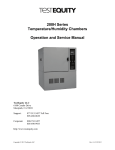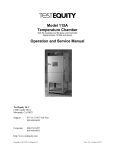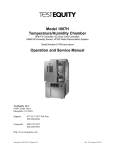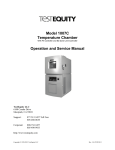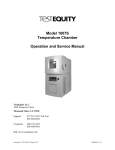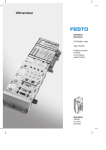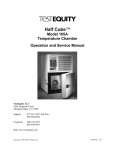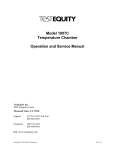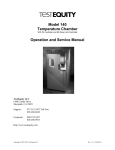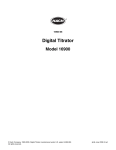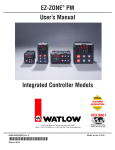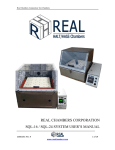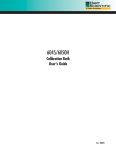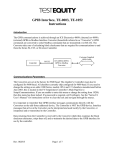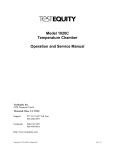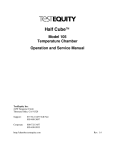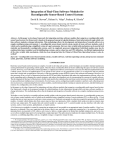Download With F4 Controller and 97 Limit
Transcript
Model 1207C Temperature/Humidity Chamber Operation and Service Manual TestEquity Inc. 2450 Turquoise Circle Thousand Oaks, CA 91320 Support: 877-512-3457 Toll Free 805-480-3697 Corporate: 800-732-3457 805-498-9933 http://www.testequity.com Copyright © 2001 TestEquity Inc. Rev. 1.01 Table of Contents Chapter 1 – Safety Instructions________________________________________________ 1-1 Introduction____________________________________________________________________ 1-1 Installation Safety Notices ________________________________________________________ 1-1 Operation Safety Notices _________________________________________________________ 1-2 Chapter 2 – Installation ______________________________________________________ 2-1 Uncrating ______________________________________________________________________ Preparation For Use _____________________________________________________________ Installation Location_____________________________________________________________ Input Power Configuration _______________________________________________________ 2-1 2-1 2-2 2-3 Overview ____________________________________________________________________________ 230 V / 60 Hz Input Configuration ________________________________________________________ 208 V / 60 Hz Input Configuration ________________________________________________________ Single Phase Configuration ______________________________________________________________ Three Phase Configuration_______________________________________________________________ 2-3 2-5 2-5 2-5 2-5 Connection to the Power Source ___________________________________________________ 2-6 Input Wiring Preparation ________________________________________________________________ 2-6 Single Phase Connection ________________________________________________________________ 2-6 Three Phase Connection _________________________________________________________________ 2-6 Humidity Water Connection ______________________________________________________ 2-7 Plumbed Demineralized Water Installation __________________________________________________ Water Recirculation System Installation ____________________________________________________ Water Recirculation System Filter Cartridge Replacement ______________________________________ Water Recirculation System Assembly _____________________________________________________ 2-7 2-7 2-7 2-8 Chapter 3 – Operation _______________________________________________________ 3-1 Introduction____________________________________________________________________ 3-1 Summary of Chamber Operation __________________________________________________ 3-1 Front Panel Switches and Lights ___________________________________________________ 3-2 Main Disconnect Switch ________________________________________________________________ Master Switch ________________________________________________________________________ Humidity Enable Switch ________________________________________________________________ Light Switch __________________________________________________________________________ Silence Switch ________________________________________________________________________ Heat Light ___________________________________________________________________________ Cool Light ___________________________________________________________________________ Humidity Light________________________________________________________________________ 3-2 3-2 3-2 3-2 3-2 3-2 3-3 3-3 Temperature/Humidity Controller _________________________________________________ 3-4 Overview ____________________________________________________________________________ 3-4 Security Features ______________________________________________________________________ 3-4 Temperature/Humidity Controller Keys and Displays __________________________________________ 3-5 Static Set Point Control _________________________________________________________________ 3-6 Digital Event Outputs___________________________________________________________________ 3-7 Digital Output Connections ______________________________________________________________ 3-7 Event Board Option ____________________________________________________________________ 3-7 Profile Programming ___________________________________________________________________ 3-8 Temperature Profile Examples____________________________________________________________ 3-9 RS-232C Interface ____________________________________________________________________ 3-10 GPIB Interface (optional)_______________________________________________________________ 3-10 Common Modbus Registers_____________________________________________________________ 3-10 Limit Controller _______________________________________________________________ 3-11 Overview ___________________________________________________________________________ Limit Controller Keys and Displays _______________________________________________________ How to Set the High and Low Temperature Safety Limits _____________________________________ Resetting a Limit Condition _____________________________________________________________ Silencing the Audible Alarm ____________________________________________________________ Protecting an Energized Test Sample______________________________________________________ 3-11 3-12 3-12 3-12 3-12 3-13 Table of Contents Loading the Chamber ___________________________________________________________ 3-14 Performance Considerations ____________________________________________________________ 3-14 Avoiding Moisture (non-humidity mode) __________________________________________________ 3-15 Internal Test Fixtures __________________________________________________________________ 3-15 Humidity Operation ____________________________________________________________ 3-16 Humidity Range ______________________________________________________________________ 3-16 Humidity Mode Considerations __________________________________________________________ 3-16 Chapter 4 – Frequently Asked Questions________________________________________ 4-1 Chapter 5 – Specifications ____________________________________________________ 5-1 Model 1207C Chamber Specifications ______________________________________________ 5-1 F4 Controller Specifications _______________________________________________________ 5-2 Humidity Sensor Specifications ____________________________________________________ 5-3 Chapter 6 – Maintenance _____________________________________________________ 6-1 Preventive Maintenance Schedule __________________________________________________ 6-1 Daily or As Needed ____________________________________________________________________ Every 3 Months _______________________________________________________________________ Every 6 Months _______________________________________________________________________ Every 12 Months ______________________________________________________________________ How to clean the chamber interior and exterior _______________________________________________ How to listen for abnormal noise or vibration ________________________________________________ How to inspect the filter cartridge _________________________________________________________ How to inspect the door seal _____________________________________________________________ How to inspect the refrigeration machinery compartment _______________________________________ How to inspect the electrical compartment __________________________________________________ How to clean the condenser ______________________________________________________________ How to verify the chamber temperature performance __________________________________________ How to drain the humidity system _________________________________________________________ How to verify the temperature calibration ___________________________________________________ How to verify the humidity calibration _____________________________________________________ Humidity Calibration Procedure __________________________________________________________ 6-1 6-1 6-1 6-1 6-1 6-1 6-2 6-2 6-2 6-2 6-3 6-4 6-5 6-6 6-7 6-8 Refrigeration System Charging Instructions _________________________________________ 6-9 R-404A High-Stage Charge ______________________________________________________________ 6-9 R-508B Low-Stage Charge ______________________________________________________________ 6-9 Series F4 Controller Setup Parameters_____________________________________________ 6-10 Series F4 System Parameters ____________________________________________________________ 6-11 Series F4 Operations Parameters _________________________________________________________ 6-12 Series F4 Set Lockout Parameters ________________________________________________________ 6-12 Series 97 Limit Controller Setup Parameters________________________________________ 6-13 Chapter 7 - Warranty________________________________________________________ 7-1 Chapter 8 – Drawings________________________________________________________ 8-1 Chapter 1 – Safety Chapter 1 – Safety Instructions Introduction Follow all CAUTION notices to prevent damage to the chamber or your test sample. Failure to follow all CAUTION notices may void your warranty. CAUTION may also indicate a potentially hazardous situation which, if not avoided, may result in minor or moderate personal injury. WARNING indicates a potentially hazardous situation which, if not avoided, could result in death or serious injury. The safety alert symbol ! precedes a general CAUTION or WARNING statement. The electrical hazard symbol 2 precedes an electric shock hazard CAUTION or WARNING statement. Installation Safety Notices ! CAUTION: The minimum clearance you should allow for proper ventilation around the chamber must be at least 12" from both the left and right side, and 24" from the rear. ! CAUTION: This chamber is designed for operation in a conditioned laboratory environment. Operation above 30°C (85°F) or below 16°C (60°F) ambient room temperature is NOT recommended. ! CAUTION: The Input Voltage label on the back of the chamber indicates the input voltage configuration as shipped from the factory. If the input voltage configuration is changed, this label must be replaced to reflect the new configuration. Replacement labels are available from TestEquity at no charge. ! CAUTION: This chamber must be properly configured for either 208 V or 230 V nominal input. 208 V and 230 V are NOT the same. Do NOT guess! Do NOT assume you have “220 V”. You must verify the exact type of electrical service you have. If there is any doubt, you must consult with a qualified electrician who is familiar with industrial plant wiring. In addition, the input line voltage should be measured while the chamber is operating in the COOL mode to ensure that the expected nominal voltage of either 208 V –5/+10% or 230 V ±10% is present. Operation below 198 V or greater than 253 V requires internal transformers, which can be supplied for a nominal charge. 2 CAUTION: This chamber should be connected to the AC power source by a qualified electrician who is familiar with industrial plant wiring. TestEquity 1207C Temperature/Humidity Chamber Page 1-1 Chapter 1 – Safety 2 CAUTION: The humidity system must be supplied with demineralized water having a specific resistance of 50,000 to 200,000 ohms/centimeter. The use of unfiltered tap water or triple-distilled water will damage the humidity system and chamber interior, and will void the warranty. Operation Safety Notices ! CAUTION: This chamber has a crankcase heater to protect the high-stage compressor. The chamber must be connected to the power source AND the Main Disconnect Switch must be ON for 3 hours prior to operating the chamber. Although it may be safe to use the chamber immediately, this procedure ensures the longest possible life for the high-stage compressor if the chamber has been removed from the power source for more than 24 hours. ! CAUTION: The “Series F4 User’s Manual” is a general manual and is written by the manufacturer, Watlow, for a wide variety of applications and configurations. Not all features or functions are applicable. Only the capabilities of a model F4DH-CCCC-01, as described on page A.7 of the “Series F4 User’s Manual” are applicable. “Cascade Control” as described on page 3.6 of the “Series F4 User’s Manual” is not applicable in this configuration. The “Retransmit” function is available as an option. ! CAUTION: The Series F4 “Alarm2” is configured for internal protection of the humidity system. Do NOT change this configuration under any circumstances. The Series F4 “Alarm1” is not connected and had no protective function in this chamber. The independent Limit Controller functions as the main system and product protection device. ! CAUTION: The Series F4 Controller has been properly configured by TestEquity to match the chamber’s system requirements and to perform optimally over a wide range of operating conditions. Improper modifications to these setup values can result in erratic performance and unreliable operation. Setup examples in the “Series F4 User’s Manual” are not applicable to this chamber. Do not attempt to modify the setup values, unless you thoroughly understand what you are doing. If there is any doubt, please call TestEquity before proceeding. ! CAUTION: Do NOT select “Full Defaults” in the Series F4 Factory Menu. “Full Defaults” are NOT the TestEquity configuration parameters for this chamber. If you select “Full Defaults”, you must reconfigure all System and Operation Parameters as documented in the TestEquity manual, NOT the “Series F4 User’s Manual”. ! CAUTION: The “Series 97 User’s Manual” is a general manual and is written by the manufacturer, Watlow, for a wide variety of applications and configurations. Not all features or functions are applicable. Only the capabilities of a model 97A0-DAAA-00-RG, as described on page A.20 of the “Series 97 User’s Manual” are applicable. Please note that only the Series 97 “Limit” functions are applicable. Page 1-2 TestEquity 1207C Temperature/Humidity Chamber Chapter 1 – Safety ! CAUTION: Always verify that the Limit Controller’s high and low limits are set to temperatures that are appropriate for your test sample. ! WARNING: Do NOT put items in the chamber that could burn or explode at high temperatures. This chamber uses open wire heating elements which generate surface temperatures over 1000ºF. This is NOT an explosion-proof chamber. ! WARNING: Do NOT put items in the chamber which can emit corrosive vapors or substances. ! WARNING: This chamber is NOT a curing oven. There are NO provisions for venting fumes. ! WARNING: The chamber door must remain closed while the chamber is operating. If you need to open the door while the chamber is operating, wear safety goggles to prevent the high velocity airflow from blowing particles or objects into your eyes. ! WARNING: This chamber operates at extreme temperatures. Avoid contact with air, objects, and surfaces that are hot or cold to prevent severe burns or frostbite. Protective gloves are recommended. ! CAUTION: If your test sample is energized, it may be capable of raising the workspace temperature beyond safe limits. This could occur if your test sample exceeds the live load rating of the chamber or if the chamber’s refrigeration system fails. This chamber has a set of contacts that can be used to remove power to your test sample if the Limit Controller’s temperature limits are exceeded. ! CAUTION: To prevent damage to your test sample and the chamber’s compressors, do not exceed the live load rating of the chamber. TestEquity 1207C Temperature/Humidity Chamber Page 1-3 Chapter 2 – Installation Chapter 2 – Installation Uncrating Inspect the shipping container for any signs of visible damage. Notify the carrier and TestEquity immediately if there are signs of shipping damage. The pallet is designed with ramps so the chamber can be rolled off without the need for a forklift or pallet jack. 1. 2. 3. 4. Cut the two metal bands that hold the packaging to the pallet. Remove the top cover. Remove the plastic fasteners that hold the outer box together and remove the outer box. Locate the retainer in the front of the pallet. Remove the two screws, then remove the retainer. Keep in mind that there is also Velcro that holds the retainer in place. Place the retainer in the front of the pallet on the floor. 5. Locate the two ramps under the chamber and remove them. 6. Attach the ramps to the front of the pallet using the Velcro straps. The retainer will be under the ramps and act as a support. 7. Carefully roll the chamber off the pallet, onto the ramps. This should be done with at least two people. Preparation For Use 1. 2. 3. 4. 5. 6. Inspect the chamber for signs of shipping damage. Read this entire manual. Select a suitable location to install the chamber. Verify the input voltage and phase configuration. Connect to the power source. Connect to humidity water source and drain OR connect to the recirculation system and fill reservoir with water. 7. Perform following the procedures as described in the Preventive Maintenance section: a. Inspect the electrical compartment. b. Inspect the refrigeration machinery compartment. c. Verify the chamber performance. The following pages discuss these steps in detail. TestEquity 1207C Temperature/Humidity Chamber Page 2-1 Chapter 2 – Installation Installation Location The chamber will produce a significant amount of heat during normal operation. Locate the chamber in a room with adequate ventilation to prevent excessive heat build-up. The chamber must be on a solid and level floor. Allow enough space around the chamber to permit serviceability and the removal of the service access panels, which are located on each side and the rear. ! CAUTION: The minimum clearance you should allow for proper ventilation around the chamber must be at least 12" from both the left and right side, and 24" from the rear. ! CAUTION: This chamber is designed for operation in a conditioned laboratory environment. Operation above 30°C (85°F) or below 16°C (60°F) ambient room temperature is NOT recommended. Page 2-2 TestEquity 1207C Temperature/Humidity Chamber Chapter 2 – Installation Input Power Configuration Overview This chamber is designed to be easily configured for operation from a Single Phase or Three Phase power source, and either 208 V / 60 Hz or 230 V / 60 Hz. Other input voltages and 50 Hz operation are available as special options, and are not covered in these instructions. Your chamber was configured prior to shipment for the particular voltage that was specified at time of order. These instructions should be used to verify the input voltage configuration prior to installation, or to change the input voltage from one configuration to another. ! CAUTION: The Input Voltage label on the back of the chamber indicates the input voltage configuration as shipped from the factory. If the input voltage configuration is changed, this label must be replaced to reflect the new configuration. Replacement labels are available from TestEquity at no charge. ! CAUTION: This chamber must be properly configured for either 208 V or 230 V nominal input. 208 V and 230 V are NOT the same. Do NOT guess! Do NOT assume you have “220 V”. You must verify the exact type of electrical service you have. If there is any doubt, you must consult with a qualified electrician who is familiar with industrial plant wiring. In addition, the input line voltage should be measured while the chamber is operating in the COOL mode to ensure that the expected nominal voltage of either 208 V –5/+10% or 230 V ±10% is present. Operation below 198 V or greater than 253 V requires internal transformers, which can be supplied for a nominal charge. TestEquity 1207C Temperature/Humidity Chamber Page 2-3 Page 2-4 208V Jump 25 to 26 203 H2 H3 2 44 230V, wire 44 on H3 208V, wire 44 on H2 F1 F2 1 Phase Jump F2 to F10 F8 to F9 F8 F9 F10 3 Phase Jump F2 to F8 INPUT L1 L2 L3 204 (1 Ph on L1, L2 only) Ground INPUT ACCESS HOLE Chapter 2 – Installation Figure 2-1 – Location of Input Configuration and Connection Terminals TestEquity 1207C Temperature/Humidity Chamber Chapter 2 – Installation NOTE: Refer to Figure 2-1 on the previous page for the location of the input configuration and connection terminals on the electrical sub panel that are described below. 230 V / 60 Hz Input Configuration 1. Turn the Main Disconnect switch to the OFF position. 2. Remove the lower door retaining screws located on the right side. Open the lower door. 3. Locate the Control Transformer, item 203. Wire number 44 must be connected to terminal H3 on the Control Transformer. 4. Locate the terminal strip on the lower left side. There must be NO jumper between terminals 25 and 26. 208 V / 60 Hz Input Configuration 1. Turn the Main Disconnect switch to the OFF position. 2. Remove the lower door retaining screws located on the right side. Open the lower door. 3. Locate the Control Transformer, item 203. Wire number 44 must be connected to terminal H2 on the Control Transformer. 4. Locate the terminal strip on the lower left side. There must be a jumper between terminals 25 and 26. Single Phase Configuration 1. Turn the Main Disconnect Switch to the OFF position. 2. Remove the lower door retaining screws located on the right side. Open the lower door. 3. Locate the row of fuses on the upper right side. There must be a jumper across the top of the fuseholder terminals F2 and F10, and another jumper across fuseholder terminals F8 and F9 (2 jumpers total). Three Phase Configuration 1. Turn the Main Disconnect Switch to the OFF position. 2. Remove the lower door retaining screws located on the right side. Open the lower door. 3. Locate the row of fuses on the upper right side. There must be a jumper across the top of the fuseholder terminals F2 and F8. TestEquity 1207C Temperature/Humidity Chamber Page 2-5 Chapter 2 – Installation Connection to the Power Source 2 CAUTION: This chamber should be connected to the AC power source by a qualified electrician who is familiar with industrial plant wiring. The Main Disconnect Switch on the front panel removes primary power to the entire chamber. All branch circuits on the load side of the Main Disconnect Switch are individually fused. However, your local electrical code may require a separate disconnect switch within sight of the chamber. Input Wiring Preparation 1. Ensure that the chamber is properly configured for Single Phase or Three Phase input as described on the previous page. 2. Remove the chamber’s right side panel. 3. Mount the input wire through the hole on the rear of the chamber, using an appropriate bushing. An additional 3-feet of wire will need to pass through the Input Access Hole in order to reach to the terminals on the electrical subpanel. The Input Access Hole is located in the corner of the partition which separates the compressor compartment from the electrical compartment. Single Phase Connection 1. Locate the Main Disconnect Switch, item 204. Remove the terminal cover from the top of this switch. 2. Connect the “Hot” input wires to terminals L1 and L2 on the Main Disconnect Switch. (the switch is marked as terminals 1 and 3 respecively). 3. Put the terminal cover back on. 4. Connect the Ground wire (NOT A NEUTRAL) to the Ground terminal. 5. Put the chamber side panel back on and close the lower door. Three Phase Connection 1. Locate the Main Disconnect Switch, item 204. Remove the terminal cover from the top of this switch. 2. Connect the “Hot” input wires to terminals L1, L2 and L2 on the Main Disconnect Switch (the switch is marked as terminals 1, 3 and 5 respecively). 3. Put the terminal cover back on. 4. Connect the Ground wire (NOT A NEUTRAL) to the Ground terminal. 5. Put the chamber side panel back on and close the lower door. Page 2-6 TestEquity 1207C Temperature/Humidity Chamber Chapter 2 – Installation Humidity Water Connection 2 CAUTION: The humidity system must be supplied with demineralized water having a specific resistance of 50,000 to 200,000 ohms/centimeter. The use of unfiltered tap water or triple-distilled water will damage the humidity system and chamber interior, and will void the warranty. Plumbed Demineralized Water Installation Follow these instructions if your chamber does not have a factory installed recirculation system, and you are connecting to a plumbed source of demineralized water. 1. Attach a supply of demineralized water to the Water Supply fitting on the chamber. 2. The chamber drain water is not under pressure, and is fed by gravity. Therefore, it must empty into an open floor drain. Alternatively, the chamber drain can empty into a condensate pump. You can purchase a condensate pump from suppliers such as Grainger (www.grainger.com). Water Recirculation System Installation The optional water recirculation system provides a source of demineralized water for the humidity system, using ordinary tap or pre-filtered water. Condensate from the chamber is returned back to the water tank. The pump operates only when needed to fill the chamber’s humidifier to the correct level. All water connections should be finger-tight only – do not use a wrench. Detailed assembly pictures are shown on the next page. 1. Attach filter cartridge. Be sure to place the rubber washers between the filter ends and the fittings. Install the cartridge with the label upside down. 2. Attach the pump outlet hose to the bottom fitting of the filter. 3. Place the pump in the water tank. 4. Attach the chamber Water Supply hose to the top fitting of the filter. 5. Attach the chamber Drain hose and position it so it goes into the water tank. 6. Fill the water tank with clean water. 7. Place the cover on the water tank. 8. Plug the pump electrical line into receptacle on the chamber. Water Recirculation System Filter Cartridge Replacement The demineralizer filter cartridge must be replaced when it is used up. The cartridge color changes gradually from the bottom up to a yellow-amber through continued use. When all but 2-inches have completely changed color, it must be replaced. Replacement cartridges are available from TestEquity (part number TE-0011 for a carton of 6 cartridges). The demineralizer filter cartridge will last longer if pre-filtered water is used. Rather than filling the recirculation system reservoir with tap water, you can use filtered drinking water (not spring water) or distilled water (supermarket quality, not triple distilled lab quality). TestEquity 1207C Temperature/Humidity Chamber Page 2-7 Chapter 2 – Installation Water Recirculation System Assembly Replace when color change reaches this line. Install with label upside down. Be sure to place the rubber washers between the filter ends and the fittings. Finger-tighten all connections. Pump placement in water tank. Water Supply and Drain connections to chamber. Finger-tighten all connections. Page 2-8 Completed installation. Plug into receptacle, turn clockwise to lock. Installation behind chamber is not recommended because it may block the air vents. TestEquity 1207C Temperature/Humidity Chamber Chapter 3 – Operation Chapter 3 – Operation Introduction The Front Panel Switches control power to the chamber. The Front Panel Lights provide indication of heat and cool functions. The Limit Controller is a protection device. It turns the chamber OFF if the workspace temperature exceeds either a high temperature or low temperature limit set point. The Temperature/Humidity Controller controls the temperature of the chamber. It can function as either a single set point controller or as a programmable profile controller. The Temperature/Humidity Controller automatically turns the refrigeration system on or off based on the demand for cooling. ! CAUTION: This chamber has a crankcase heater to protect the high-stage compressor. The chamber must be connected to the power source AND the Main Disconnect Switch must be ON for 3 hours prior to operating the chamber. Although it may be safe to use the chamber immediately, this procedure ensures the longest possible life for the high-stage compressor if the chamber has been removed from the power source for more than 24 hours. Summary of Chamber Operation 1. 2. 3. 4. 5. 6. Turn the Main Disconnect Switch ON. Enter the appropriate high and low temperature safety limits on the Limit Controller. Enter the desired set points (or program) on the Temperature/Humidity Controller. Load your test sample in the chamber. If you are running a controlled humidity condition, turn the Humidity Enable Switch ON. Turn the Master Switch ON. TestEquity 1207C Temperature/Humidity Chamber Page 3-1 Chapter 3 – Operation Front Panel Switches and Lights Main Disconnect Switch The Main Disconnect Switch controls power to the entire chamber and provides a mechanical safety interlock to the lower door. In the ON position (clockwise) primary power is connected. The Temperature/Humidity Controller, Limit Controller, and (optional) Chart Recorder are always functional when the Main Disconnect Switch is ON, regardless of the Master Switch position. The Main Disconnect Switch should be left ON if the chamber is usually used on a daily basis. In the OFF position (counter clockwise) primary power is disconnected. The Main Disconnect Switch can be left OFF if the chamber is not used on a daily basis. It can also be locked in the OFF position with a padlock. ! CAUTION: This chamber has a crankcase heater to protect the high-stage compressor. The chamber must be connected to the power source AND the Main Disconnect Switch must be ON for 3 hours prior to operating the chamber. Although it may be safe to use the chamber immediately, this procedure ensures the longest possible life for the high-stage compressor if the chamber has been removed from the power source for more than 24 hours. Master Switch The Master Switch enables all chamber functions. The Master Switch illuminates when it is ON. Humidity Enable Switch The Humidity Enable Switch activates the controlled humidity mode. In this mode, the cooling capacity is reduced. The Humidity Enable Switch illuminates when it is ON (if the chamber temperature is between +7°C and +90°C). If the chamber temperature is less that +7°C or more than +90°C, the Humidity system is disabled. This switch should ONLY be ON if you are performing a controlled humidity test within the humidity range of the chamber. Light Switch The Light Switch controls the workspace light. The Light Switch illuminates when it is ON. Silence Switch The Limit Controller will sound an Audible Alarm in the event of an over-temperature or undertemperature condition. The Silence Switch lets you temporarily turn off the Audible Alarm. Heat Light The Heat Light will illuminate when the Temperature/Humidity Controller turns on the heater to maintain the workspace temperature. The Heat Light will cycle on/off as the workspace temperature approaches and reaches the temperature set point. This light corresponds to the 1A indicator on the Temperature/Humidity Controller. Page 3-2 TestEquity 1207C Temperature/Humidity Chamber Chapter 3 – Operation Cool Light The Cool Light will illuminate when the Temperature/Humidity Controller turns on the cooling valve to maintain the workspace temperature. The Cool Light will cycle on/off as the workspace temperature approaches and reaches the temperature set point. This light corresponds to the 1B indicator on the Temperature/Humidity Controller. Humidity Light The Humidity Light will illuminate when the Temperature/Humidity Controller turns on the humidifier heater to maintain the workspace humidity. The Humidity Light will cycle on/off as the workspace humidity approaches and reaches the humidity set point. This light corresponds to the 2A indicator on the Temperature/Humidity Controller. Note that the Humidity Enable Switch must be ON, the chamber workspace must be between +7°C and +90°C, and the humidifier water level must be correct for the Humidity Light to correspond to the 2A indicator on the Temperature/Humidity Controller. The 2B indicator on the Temperature/Humidity Controller lights with dehumidification is required to maintain the workspace humidity. There is no corresponding light on the front panel for this function. TestEquity 1207C Temperature/Humidity Chamber Page 3-3 Chapter 3 – Operation Temperature/Humidity Controller Overview This section provides a brief overview on how to operate the Series F4 Controller in the static set point mode. For more detailed instructions, see the “Series F4 User’s Manual”. The Series F4 Controller can function as either a single set point controller (static mode) or as a programmable profile controller. A four-line LCD display facilitates setup and programming, and presents informative messages about status, error, and alarm conditions. Digital outputs, profiles, and alarms can be named for easy reference. An Information Key gives you quick information about the pages, menus, parameters and values, as well as error and alarm conditions if they occur. The user-interface is organized into five “pages” of menus. The Main Page provides access to the other four pages – Operations, Profiles, Setup, and Factory. ! CAUTION: The “Series F4 User’s Manual” is a general manual and is written by the manufacturer, Watlow, for a wide variety of applications and configurations. Not all features or functions are applicable. Only the capabilities of a model F4DH-CCCC-01, as described on page A.7 of the “Series F4 User’s Manual” are applicable. “Cascade Control” as described on page 3.6 of the “Series F4 User’s Manual” is not applicable in this configuration. The “Retransmit” function is available as an option. ! CAUTION: The Series F4 “Alarm2” is configured for internal protection of the humidity system. Do NOT change this configuration under any circumstances. The Series F4 “Alarm1” is not connected and had no protective function in this chamber. The independent Limit Controller functions as the main system and product protection device. ! CAUTION: The Series F4 Controller has been properly configured by TestEquity to match the chamber’s system requirements and to perform optimally over a wide range of operating conditions. Improper modifications to these setup values can result in erratic performance and unreliable operation. Setup examples in the “Series F4 User’s Manual” are not applicable to this chamber. Do not attempt to modify the setup values, unless you thoroughly understand what you are doing. If there is any doubt, please call TestEquity before proceeding. Security Features The Series F4 Controller has several levels of security to prevent unauthorized users from changing critical configuration parameters. Only the Set Point and Profile menus have “Full Access”. TestEquity has configured all other menus to “Read Only”, and have protected them with a password. TestEquity does not recommend that these security levels be changed for most applications. However, there will be times when “Full Access” is necessary. For example, you may need to gain access to Setup Page in order to change from °C to °F display, or to change the time or date. You must call TestEquity at 877-512-3457 or 805-480-3697 to obtain the password. Page 3-4 TestEquity 1207C Temperature/Humidity Chamber Chapter 3 – Operation Temperature/Humidity Controller Keys and Displays Upper Display Displays actual chamber temperature during operation. Displays error information if errors occur. Lower Display Displays information about the setup, operation and programming of the controller. Alarm Output Indicator Lights Lit during an alarm state. Alarm2 is lit when temperature is outside the range for humidity mode. Cursor Indicates selected parameter or present value in memory. Moves via the four navigation keys. Communications Indicator Light Lit (pulsates) when the controller sends or receives valid data. Profile Indicator Light Lit when a ramping profile runs. When blinking, the profile is on hold. When not lit, the controller operates as a static set point controller. Profile Key Summons a menu that allows you to start, hold, resume or terminate a profile. Output Indicator Lights 1A = Heat 1B = Cool 2A = Humidity 2B = Dehumidify Scroll Bar Appears when the Up or Down Keys can reveal more information in the Lower Display. Information Key Provides information in the Lower Display about the cursorselected parameter. Another press toggles the display back to the parameter. Left and Right Keys Move right to select the choice to the right of the cursor and proceed to the next screen. Move left to exit. Up and Down Keys Move the cursor position in the Lower Display through the software in the direction of the key arrow. Increase or decrease a value, or change a letter in a user-nameable field, such as events and profile names. Figure 4.1 – Temperature/Humidity Controller Keys and Displays • • • • The actual chamber workspace temperature is indicated on the Upper Display. The actual chamber workspace humidity is displayed on the Lower Display at the Input2 prompt. The temperature set point is entered at the SP1 prompt in the Lower Display. The humidity set point is entered at the SP2 prompt in the Lower Display. TestEquity 1207C Temperature/Humidity Chamber Page 3-5 Chapter 3 – Operation Static Set Point Control The Temperature/Humidity Controller is in Static Mode when it is not controlling a Profile. When in a Static Mode, the Profile Indicator Light is off. The Static Set Point prompt is accessed from the Main Page on the Lower Display. ¿ To enter a Static Temperature Set Point: 1. Press the ¿ or ¯ key to position the Cursor next to the SP1 prompt. You may already be at this prompt. 2. Press the key once. You will see Static Set Point1 in the lower display with the current set point indicated below. 3. Press the ¿ or ¯ key to change the temperature set point. 4. Press the key once to enter the new temperature set point. You are now back to the Main Page. ¿ ¿ To enter a Static Humidity Set Point: 1. Press the ¿ or ¯ key to position the Cursor next to the SP2 prompt. You may already be at this prompt. 2. Press the key once. You will see Static Set Point2 in the lower display with the current set point indicated below. 3. Press the ¿ or ¯ key to change the humidity set point. Page 3-6 ¿ 4. Press the Page. key once to enter the new humidity set point. You are now back to the Main TestEquity 1207C Temperature/Humidity Chamber Chapter 3 – Operation Digital Event Outputs The Temperature/Humidity Controller has digital outputs which are configured as Event Outputs to turn remote devices on and off. There are seven Event Outputs which are available for customer use. Output number eight is configured to control the refrigeration compressors and is not available for customer use. The Event Output control is accessed from the Main Page. ¿ To control the Event Outputs: 1. Press the ¿ or ¯ key to position the Cursor next to the DigitalOut prompt. 2. Press the key once. You will see Choose Event Output prompt in the lower display. 3. Press the ¿ or ¯ key to position the Cursor next to the EventOutput prompt which you want to change. You will be able to select from EventOutput1 through EventOutput7. ¿ ¿ ¿ 4. Press the key once to select the desired EventOutput. Then, press the ¿ or ¯ key to select On or Off. 5. Press the key once to return to the Choose Event Output prompt. 6. Press the key once to return back to the Main Page. Digital Output Connections See page 12.9 of the “Series F4 User’s Manual” for details on how to connect to the Digital Outputs. Event Board Option Your chamber may have been ordered with the Event Board option. The event board contains solid state relays to control AC operated devices. The solid state relays are rated for 24 to 240 VAC, 3.0 Amps. However, TestEquity recommends derating the maximum current to 2.5 Amps. The solid state relay mounting board is UL recognized/CSA certified for 120 VAC max. with the board-mounted fuses; 250 VAC max. with a #22 solid copper jumper wire instead of the fuses. Connecting to the Event Board 1. Turn the Main Disconnect switch to the OFF position. 2. Remove the lower door retaining screws located on the right side. Open the lower door. 3. The Event Board is located on the top of the lower door. Connect to the event outputs as follows: Event Output Event 1 Event 2 Event 3 Event 4 Event 5 Event 6 Event 7 Event Board Terminals 1, 2 3, 4 5, 6 7, 8 9, 10 11, 12 13, 14 Event Board Terminals 4. The lead wires can be brought out through the access hole on the left side of the chamber (next to the interface connector). TestEquity 1207C Temperature/Humidity Chamber Page 3-7 Chapter 3 – Operation Profile Programming The Series F4 Controller can be programmed to store up to 256 steps into as many as 10 profiles. You do not need a computer to enter a profile – it can be easily done through the controller’s front panel keys. For detailed information about how to program a profile, see Page 4.1 of the “Series F4 User’s Manual”. For detailed information about how to run a profile, see Page 3.2 of the “Series F4 User’s Manual”. ! CAUTION: The sample program in the “Series F4 User’s Manual” is not applicable to this chamber. ! CAUTION: The Series F4 Controller has been properly configured by TestEquity to match the chamber’s system requirements and to perform optimally over a wide range of operating conditions. Improper modifications to these setup values can result in erratic performance and unreliable operation. Setup examples in the “Series F4 User’s Manual” are not applicable to this chamber. Do not attempt to modify the setup values, unless you thoroughly understand what you are doing. If there is any doubt, please call TestEquity before proceeding. Programming Hints: • The first step in a program should be an initialization step of 1-second. • The next to last step establishes a condition to end on. For example, you may want to end the program by holding at +23°C, so this step would be to go to +23°C. • TestEquity recommends having the end step type to be Hold or Idle. • TestEquity does NOT recommend using an end step type of All Off or Control Off. This does not turn off the chamber fan. The chamber temperature can reach +55°C just from heat generated by the fan, and even higher if your test sample is energized. Page 3-8 TestEquity 1207C Temperature/Humidity Chamber Chapter 3 – Operation Temperature Profile Examples The following are examples of two typical temperature-only profiles. 1 > > > > > > — Choose Digit Out 2 3 4 5 6 > > > > > > > > > > > > > > > > > > > > > > > > > > > > > > — — — — — 7 > > > > > > — H:M:S 00:00:01 00:30:00 00:00:01 00:30:00 — 00:00:01 — Ch1 Ch2 SP SP -40.0 > — > 85.0 > — > — — 23.0 > — — PID Set Ch1 Ch2 1 6 1 6 1 6 1 6 — — 1 6 — — -40ºC to 85ºC, uncontrolled humidity, no ramps, 30 minute soak time, 4 cycles. Ends with +23ºC set point. Wait for > > > > > > — Description Goes to -40ºC as quickly as possible. Will hold for 30 minutes. Time will not start until chamber reaches -37ºC (within the 3º Guaranteed Soak Band*). Goes to +85ºC as quickly as possible. Will hold for 30 minutes. Time will not start until chamber reaches +82ºC (within the 3º Guaranteed Soak Band*). Jumps back to step 1. Repeats this 3-times, for a total of 4-cycles. Goes to +23ºC as quickly as possible. End of program. Controller returns to a +23ºC manual set point. Step Step Date Number Type Day, Time 1 Ramp Time — 2 Soak — 3 Ramp Time — 4 Soak — 5 Jump — 6 Ramp Time — 7 End — Step 1 2 3 4 5 6 7 1 On On On Off Off On > Off — Choose Digit Out 2 3 4 5 6 > > > > > > > > > > > > > > > > > > > > > > > > > > > > > > > > > > > > > > > > — — — — — 7 > > > > > > > > — Time H:M:S 00:00:01 00:13:30 01:00:00 00:25:00 01:00:00 00:25:00 — 00:13:30 — Ch1 SP 23.0 50.0 — 0.0 — 50.0 — 23.0 — Ch2 SP > > > > > > — > — PID Set Ch1 Ch2 1 6 1 6 1 6 1 6 1 6 1 6 — — 1 6 — — Guar. Soak Jump to Ch1 Ch2 Profile Step No No — — Yes No — — No No — — Yes No — — — — Name 1 No No — — — — — — Guar. Soak Jump to Ch1 Ch2 Profile Step No No — — No No — — No No — — No No — — No No — — No No — — — — Name 2 No No — — — — — — End Repeats Type — — — — — — — — 3 — — — — Idle End Repeats Type — — — — — — — — — — — — 99 — — — — Idle Idle SP Ch1 — — — — — — 23.0 Idle SP Ch1 — — — — — — — — 23.0 +50ºC to 0ºC, 2ºC/minute ramp, uncontrolled humidity, 1-hour soak times, 100 cycles total, test sample turned ON/OFF depending on step, end with a +23ºC set point. Wait for > > > > > > > > — Description Establishes an initialization step. Goes to +23ºC as quickly as possible. Test sample is turned ON via Event 1. Goes to +50ºC at a controlled rate of 2ºC per minute (50-23=27/2=13.5 or 13 minutes and 30 seconds). Test sample is turned ON via Event 1. Will hold for 1 hour. Test sample remains ON via Event 1. Goes to 0ºC at a controlled rate of 2ºC per minute (50-0=50/2=25 or 25 minutes). Test sample is turned OFF via Event 1. Will hold for 1 hour. Test sample remains OFF via Event 1. Goes to 50ºC at a controlled rate of 2ºC per minute. Test sample is turned OFF via Event 1. Jumps back to step 3. Repeats this 99-times, for a total of 100-cycles. After all cycles are completed, establishes the condition to end on. Goes to +23ºC at a controlled rate of 2ºC per minute. Test sample is turned OFF via Event 1. End of program. Controller returns to a +23ºC manual set point. Test sample remains OFF via Event 1. Step Step Date Number Type Day, Time 1 Ramp Time — 2 Ramp Time — 3 Soak — 4 Ramp Time — 5 Soak — 6 Ramp Time — 7 Jump — 8 Ramp Time — 9 End — Step 1 2 3 4 5 6 7 8 9 Notes * Guaranteed Soak Band is set at the factory for 3.0ºC. Can be changed in the System Menu. > Means no entry or selection is required. Just scroll through this prompt to the next prompt. — Means prompt does not show for this step type. Page 3-9 TestEquity 1207C Temperature/Humidity Chamber Chapter 3 – Operation RS-232C Interface The Temperature/Humidity Controller has an RS-232C interface. A DB-9 connector is located on the front left side. It is wired to accommodate a null-modem cable. To communicate with the controller from a PC, you need to run software that uses the Modbus RTU protocol. industrial data communications. This protocol works on the principle of packet exchanges. The packet contains the address of the controller to receive the information, a command field that says what is to be done with the information and several fields of data. Reading from these registers retrieves all information in the controller. These registers are listed Chapter Seven of the “Series F4 User’s Manual”. RS-232C and Modbus programming resources can be downloaded from http://chamber.testequity.com/rs232.html . GPIB Interface (optional) The optional GPIB interface consists of an internal board which converts the controller’s serial interface to GPIB. GPIB programming resources can be downloaded from http://chamber.testequity.com/gpib.html . Common Modbus Registers • • • • • • • The actual chamber temperature reading is Modbus register 100 (Input 1 Value). The actual chamber humidity reading is Modbus register 104 (Input 2 Value). The static temperature setpoint is Modbus register 300 (Set Point 1). The static humidity setpoint is Modbus register 319 (Set Point 2). The temperature setpoint during a profile is Modbus register 4122 (Set Point 1, Current Profile Status). The humidity setpoint during a profile is Modbus register 4123 (Set Point 2, Current Profile Status). The decimal points are implied. For example, 1005 is actually 100.5 and -230 is -23.0. Page 3-10 TestEquity 1207C Temperature/Humidity Chamber Chapter 3 – Operation Limit Controller Overview The Series 97 Limit Controller is a protection device. It turns the chamber OFF if the workspace temperature exceeds either a high temperature or low temperature limit. You can set these limits to correspond to the maximum and minimum temperature that your test sample can safely withstand. This provides protection against someone setting the Temperature/Humidity Controller to a temperature that is unsafe for the test sample. It also provides protection in the unlikely event of a chamber system component failure. The Limit Controller has its own temperature sensor (thermocouple) and functions completely independent of the Temperature/Humidity Controller. This section provides a brief overview on how to operate the Limit Controller. For more detailed instructions, see the “Series 97 User’s Manual”. ! CAUTION: The “Series 97 User’s Manual” is a general manual and is written by the manufacturer, Watlow, for a wide variety of applications and configurations. Not all features or functions are applicable. Only the capabilities of a model 97A0-DAAA-00-RG, as described on page A.20 of the “Series 97 User’s Manual” are applicable. Please note that only the Series 97 “Limit” functions are applicable. ! CAUTION: Always verify that the Limit Controller’s high and low limits are set to temperatures that are appropriate for your test sample. ! CAUTION: If your test sample is energized, it may be capable of raising the workspace temperature beyond safe limits. This could occur if your test sample exceeds the live load rating of the chamber or if the chamber’s refrigeration system fails. This chamber has a set of contacts that can be used to remove power to your test sample if the Limit Controller’s temperature limits are exceeded. TestEquity 1207C Temperature/Humidity Chamber Page 3-11 Chapter 3 – Operation Limit Controller Keys and Displays Active Output Indicator Lights Lit when the corresponding output trips. Only output 1 is applicable for this configuration. Upper Display Indicates actual process values during operation, the value for the parameter in the lower display, or the user programmed message. Lower Display Indicates factory programmed message during operation, the value for the parameter in the lower display, or the user programmed message. Advance Key Advances the lower display through the parameters. To reverse direction, press and hold the Advance Key while repeatedly pressing the UP Key. Up Key Changes the upper display to a higher value, or up through a list of values. Moves from menu to menu in a page. Down Key Changes the upper display to a lower value, or down through a list of values. Moves from menu to menu in a page. Reset Key • Returns to the Home Page (process/actual display). • Resets the limit. • Resets an input sensor error. Figure 4.1 – Limit Controller Keys and Displays How to Set the High and Low Temperature Safety Limits 1. Press the ¿ and ¯ Keys together for three seconds, until the [OPER] prompt appears in the Lower Display. The Upper Display should say [LIM]. 2. Press the ‰ Key once to get the [L~Lo] prompt. This is the Low Limit Set Point prompt. 3. Press the ¿ or ¯ Key to enter the desired Low Limit Set Point. Make sure it is at least a few degrees lower than your lowest temperature set point to prevent nuisance tripping. 4. Press the ‰ Key once to get the [L~Hi] prompt. This is the High Limit Set Point prompt. 5. Press the ¿ or ¯ Key to enter the desired High Limit Set Point. Make sure it is at least a few degrees higher than your highest temperature set point to prevent nuisance tripping. 6. Press the RESET Key to save these values and return to the Home Page. If you press the ‰ Key after the [L`Hi] prompt, you will get the [CAL1] prompt, which is the Calibration Offset. This is an adjustment to eliminate a difference between the indicated value and the actual process value. Resetting a Limit Condition If either the High or Low Limit is exceeded, the Limit Controller will indicate either [L~Hi] or [L~Lo] respectively in the lower display. It will also shut down all chamber functions and sound the Audible Alarm. The Limit Controller cannot be reset until the temperature returns to within the limit set points. Then, you must press the RESET Key to resume normal operation. Silencing the Audible Alarm The SILENCE switch on the chamber front panel lets you temporarily turn off the Audible Alarm, even though the High or Low Limit condition may still exist. Page 3-12 TestEquity 1207C Temperature/Humidity Chamber Chapter 3 – Operation Protecting an Energized Test Sample If your test sample is energized, it may be capable of raising the workspace temperature beyond safe limits. This could occur if your test sample exceeds the live load rating of the chamber or if the chamber’s refrigeration system fails. This chamber has a set of safety contacts that can be used to remove power to your test sample if the Limit Controller’s temperature limits are exceeded. The safety contacts are rated as follows: Resistive: 10 A, 250 VAC or 10 A, 28 VDC Inductive: 7 A, 250 VAC To access the safety contacts: 1. Turn the Main Disconnect Switch to the OFF position. 2. Remove the lower door retaining screws located on the right side. Open the lower door. 3. Locate the terminal strip on the lower left side. Connections to the safety contacts are at terminals 8 and 9. TestEquity 1207C Temperature/Humidity Chamber Page 3-13 Chapter 3 – Operation Loading the Chamber ! WARNING: Do NOT put items in the chamber that could burn or explode at high temperatures. This chamber uses open wire heating elements which generate surface temperatures over 1000ºF. This is NOT an explosion-proof chamber. ! WARNING: Do NOT put items in the chamber which can emit corrosive vapors or substances. ! WARNING: This chamber is NOT a curing oven. There are NO provisions for venting fumes. ! WARNING: The chamber door must remain closed while the chamber is operating. If you need to open the door while the chamber is operating, wear safety goggles to prevent the high velocity airflow from blowing particles or objects into your eyes. ! WARNING: This chamber operates at extreme temperatures. Avoid contact with air, objects, and surfaces that are hot or cold to prevent severe burns or frostbite. Protective gloves are recommended. ! CAUTION: If your test sample is energized, it may be capable of raising the workspace temperature beyond safe limits. This could occur if your test sample exceeds the live load rating of the chamber or if the chamber’s refrigeration system fails. This chamber has a set of contacts that can be used to remove power to your test sample if the Limit Controller’s temperature limits are exceeded. ! CAUTION: To prevent damage to your test sample and the chamber’s compressors, do not exceed the live load rating of the chamber. Live Load Capacity for Model 1207C (non-humidity mode) Temp +23°C 0°C –40°C –55°C –65°C Watts 1000 W 800 W 500 W 400 W 300 W Performance Considerations The performance of all chambers are significantly effected by the characteristics of your test sample. Factors include size, weight, material, shape, and power dissipation if energized. The test sample should be placed in the chamber in a manner that allows for air circulation. The air plenum is located on the back wall of the chamber, where air is sucked in from the bottom and exits from the top. You should not place the test sample directly on the chamber floor. It should be placed on the shelf. Multiple test samples should be distributed throughout the chamber to ensure even airflow and minimize temperature gradients. If necessary, additional shelves should be used to evenly distribute the load. Verify that the temperature gradients are within acceptable limits, by measuring the chamber temperature at strategic points using a multipoint thermocouple meter or datalogger. Page 3-14 TestEquity 1207C Temperature/Humidity Chamber Chapter 3 – Operation You may find that the temperature throughout the chamber is even, but always different from what the Temperature/Humidity Controller indicates. The correct way to adjust what the Temperature/Humidity Controller “displays” compared to what is measured at some point other than the controller’s sensor is with the “Calibration Offset” parameter. See page 6.2 of the “Series 97 User’s Manual” for details. Avoiding Moisture (non-humidity mode) Any time the ambient air is subjected to temperatures below the dewpoint, moisture will condense out of the air. The effect is ice or frost during low temperature operation. When the chamber is heated above 0°C, the ice or frost will turn into water. To avoid moisture condensation, make sure the port plugs are inserted at all times and properly seal around any wires that go through the port. Also, avoid opening the chamber door while the chamber is operating at temperatures below room ambient. When a low temperature test is completed, warm the chamber to at least room ambient before opening the chamber door and before removing your test sample. You CANNOT use the humidity system to control moisture at low temperatures. The humidity system is disabled below 7°C. Internal Test Fixtures Some applications require internal fixtures to support test samples and provide a convenient method of connecting wires and sensors. Fixtures must be designed to minimize their impact on chamber functionality and performance. Fixtures should be designed for easy removal to permit maintenance and cleaning of the chamber. The chamber liner should never be drilled or screwed into. This will compromise the integrity of the liner and permit moisture migration due to condensation into the insulation, which will eventually impact performance and lead to premature rusting of the outer cabinet. Fixtures should be constructed of stainless steel. This also applies to all screws and fasteners. All welds should be passivated. To prevent rust and corrosion, never use iron or mild steel even if it is painted or plated. Aluminum may be used. However, since the specific heat of aluminum is double that of steel, it represents a greater load and will have more impact on the chamber performance. Make sure that all connectors, wiring, pc boards, and auxiliary components can withstand the temperature extremes that they will be subjected to. In some cases, these components may not be able to last after repeated tests and should be considered expendable. TestEquity 1207C Temperature/Humidity Chamber Page 3-15 Chapter 3 – Operation Humidity Operation Humidity Range This chamber is capable of controlling humidity from 10% RH to 95% RH over the temperature range of +10°C to +85°C. The lowest possible humidity varies depending on the temperature. For example, +45°C is the lowest temperature that 10% RH can be achieved. Below is a chart that shows the achievable range of humidity as compared to temperature. Achieving low humidity levels require you to start with a clean, dry chamber. 100 RELATIVE HUMIDITY (% RH) 90 80 70 Achievable Range of Temperature/Humidity Conditions 60 50 40 30 20 10 0 0 32 10 50 20 68 30 86 40 104 50 122 60 140 70 158 80 176 90 194 °C °F TEMPERATURE Humidity Mode Considerations This chamber is in controlled humidity mode when the Humidity Enable switch is ON. Also, the chamber workspace must be between +7°C and +90°C. If the chamber is outside this temperature range, the Temperature/Humidity Controller’s Alarm2 light will turn ON and the chamber will operate as though the Humidity Enable switch was OFF. It takes several minutes for the humidifier to fill to the correct level after the water supply is initially connected to an empty system. The humidifier function is disabled until the water level is correct. If you are running a high humidity condition, it can take approximately 15-20 minutes until the humidifier heats up from an initial “cold start”. During most of that time, it might appear that “nothing is happening” because there is little increase in the humidity reading (the Input2 prompt) on the Temperature/Humidity Controller. Be patient - as long as the Humidity Light is ON, then the humidity will eventually begin to rise after this initial heat-up period. Page 3-16 TestEquity 1207C Temperature/Humidity Chamber Chapter 4 – Frequently Asked Questions Chapter 4 – Frequently Asked Questions The input voltage label says 230 (or 208) VAC. I thought I had 220 (or 240) VAC. Is that ok? 220 V is a misnomer—there is no such standard as nominal 220 V in the United States. You must verify the exact type of electrical service you have. If there is any doubt, you must consult with a qualified electrician who is familiar with industrial plant wiring. In addition, the input line voltage should be measured while the chamber is operating in the COOL mode to ensure that the expected nominal voltage of either 208 V –5/+10% or 230 V ±10% is present. Also, make sure the chamber is properly configured for either 208 V or 230 V nominal input as described in Chapter 2 - Input Power Configuration. If you have a 208 V line that measures under 198 V, the chamber will require boost transformers. If you have a 240 V line that measures over 252 V (a 240 V line that is 10% high could measure up to 264 V), the chamber will require bucking transformers. These transformers are available from TestEquity (part number TE-0702F) for a reasonable cost and are easy to install in the field. Why doesn’t the chamber come with a power cord and plug? Most local electrical codes require permanent wiring for this type of equipment. If used as a portable device, a flexible wire with a plug may be acceptable, but local codes may limit the length to 6 feet. TestEquity recommends that the appropriate method for your installation be determined by a qualified electrician who is familiar with industrial plant wiring. I need to send the chamber outside North America. Will it work with their power? Outside North America, most countries have 50 Hz. Standard voltages in Europe are typically 220 V to 240 V, while Japan is 200 V. Operation at 220 V to 240 V / 50 Hz requires bucking transformers to lower the voltage at the compressors to their 50 Hz rating of 200 V. These transformers are available from TestEquity for a reasonable cost and is easy to install in the field. Note that the cooling performance will be reduced by 17% at 50 Hz. Please call TestEquity for details on reconfiguring for 50 Hz operation. Why does my chamber heat or cool slower than the published specifications? Performance is significantly effected by the characteristics of your test sample. Factors include size, weight, material, shape, and power dissipation if energized. The test sample should be placed in the chamber in a manner that allows for air circulation. You should not place the test sample directly on the chamber floor. It should be placed on the shelf. Multiple test samples should be distributed throughout the chamber to ensure even airflow and minimize temperature gradients. If necessary, additional shelves should be used to evenly distribute the load. You can determine if the chamber is operating properly by following the procedure in “How to verify the chamber performance”. How can I modify the chamber to cool faster? Unfortunately, there is little you can do to improve upon the designed-in performance. TestEquity does NOT recommend using CO2 or LN2 in this chamber to achieve faster cooling due to reliability and safety considerations, so it is NOT an available option. Modifying the chamber to add CO2 or LN2 will void the warranty. TestEquity 1207C Temperature/Humidity Chamber Page 4-1 Chapter 4 – Frequently Asked Questions Why is there water/ice/snow in the chamber? Any time the ambient air is subjected to temperatures below the dewpoint, moisture will condense out of the air. The effect is ice or frost during low temperature operation. When the chamber is heated above 0°C, the ice or frost will turn into water. To avoid moisture condensation, make sure the port plugs are inserted at all times. Also, avoid opening the chamber door while the chamber is operating at temperatures below room ambient. When a low temperature test is completed, warm the chamber to at least room ambient before opening the chamber door and before removing your test sample. My test specification requires convection heat only. Can I turn the circulator motor off? NO! This will damage the heating and refrigeration systems and void the warranty. You need a “gravity convection oven” for that kind of test. How accurate is the chamber? That’s a loaded question! There is no “chamber accuracy” specification as such. The answer requires an understanding of several performance parameters. Control Tolerance – The Temperature/Humidity Controller uses a thermocouple control sensor, which is located in the discharge airflow. Control tolerance is a measure of how much the temperature varies after stabilization at the control sensor. It is a measure of the relative variations, NOT the absolute accuracy of the readout. The control tolerance specification for this chamber is ±0.5°C, or a total of 1°C. For example, the temperature set point may be –25.0°C. The actual temperature varies between –25.4°C and –24.5°C. This corresponds to –0.4°C and +0.5°C or a total of 0.9°C of RELATIVE variations. These specifications are for an empty chamber. The addition of a test sample may effect the control variations. In some instances, the test sample will reduce these variations. Uniformity – Also known as Gradients. This is a measure of variations in temperature at different locations throughout the chamber interior, at the same time, after stabilization. The uniformity specification for this chamber is ±0.5°C or a total of 1°C, when measured at least 2" away from the chamber interior walls. These specifications are for an empty chamber. The addition of a test sample may effect the temperature uniformity. For example, an energized test sample will produce a higher temperature near the sample. Controller Accuracy – This is the ability of the Temperature/Humidity Controller to accurately display a temperature measurement when compared to a standard. The controller display accuracy is ±0.65°C, ±1 LSD. However, the total measurement accuracy in the chamber includes the thermocouple sensor wire accuracy. Thermocouple wire accuracy is ±1°C or 0.75% of reading, whichever is greater. Therefore, total system accuracy over the chamber’s typical operating range is typically ±1.65°C, ±1 LSD. This is not a measurement of chamber performance. Can I tilt the chamber to move it? You should be able to tilt the chamber 45 degrees to move it. After tilting it and moving it into place, perform the steps as outlined in “How to inspect the refrigeration machinery compartment” and “How to check the refrigerant charge” before placing the chamber back into service to make sure that no damage has occurred. Page 4-2 TestEquity 1207C Temperature/Humidity Chamber Chapter 4 – Frequently Asked Questions I’m not going to use the chamber for a while. Is there anything I should do to prepare it for storage? Perform ALL the steps in the Preventive Maintenance Schedule before placing the chamber into storage. This will ensure that the chamber will be ready to operate when it is taken out of storage. If the chamber has a problem and is still under warranty, these problems should be resolved before being placed into storage, since the warranty period starts from the date of shipment. The chamber should be stored in a conditioned environment. Do not store it outside or where it will be subjected to dirt or excessive moisture. I haven’t used the chamber for a while. Is there anything I should do to prepare it for operation? Perform ALL the steps in the Preventive Maintenance Schedule before placing the chamber back into service. This will ensure that nothing has been damaged and that a leak has not developed. This chamber has a crankcase heater to protect the high-stage compressor. The chamber must be connected to the power source AND the Main Disconnect Switch must be ON for 3 hours prior to operating the chamber. Although it may be safe to use the chamber immediately, this procedure ensures the longest possible life for the high-stage compressor if the chamber has been removed from the power source for more than 24 hours. Can the person who services our air conditioning also service the chamber? Probably not. Most air conditioning mechanics are not familiar with low-temperature cascade refrigeration systems. While this chamber is relatively easy to maintain and repair, most air conditioning mechanics do not have the necessary refrigerants and may not be familiar with the microprocessor-based controls. This chamber should only be serviced by a qualified mechanic that is familiar with low-temperature cascade refrigeration systems. Call TestEquity to recommend one in your area or to check if the one you would like to use is qualified. Can/Should I put a filter in front of the condenser air inlet? No, TestEquity does not recommend this. Just follow the maintenance procedures and clean the condenser fins periodically. How often should I charge the refrigeration system? This chamber uses a closed-loop refrigeration system. Just like your refrigerator at home, it does not need periodic charging. If the charge is low, this means that there is a leak. Leaks should be repaired before recharging. What kind of Freon does the chamber use? The word Freon® is a DuPont registered trade name for their CFC-based refrigerants and is incorrectly used as a generic term for refrigerants. TestEquity chambers do not use CFC-based refrigerants. The high-stage system uses R-404A, which is also known as DuPont Suva® HP62. The low-stage system uses R-508B, which is also known as DuPont Suva® 95. TestEquity 1207C Temperature/Humidity Chamber Page 4-3 Chapter 5 – Specifications Chapter 5 – Specifications Model 1207C Chamber Specifications Temperature Range Control Tolerance Uniformity –75°C to +175°C ±0.5°C (±0.2°C Typical) (Measured at the control sensor after stabilization) ±0.5°C (Variations throughout the chamber after stabilization) Humidity Range 10%RH to 95%RH, in the temperature range of 10°C to 85°C. Low humidity range limited by a 6°C dewpoint. ±2%RH (Measured at the control sensor after stabilization) Control Tolerance Live Load Capacity @ +23°C 0°C 1000 W 800 W (Live load capacity for non-humidity mode) –40°C 500 W –55°C 400 W –65°C 300 W +23°C 18 min End Temp 0°C –40°C 25 min 44 min –55°C 54 min –65°C 62 min –75°C ultimate +23°C ----1.5 min 6 min 8 min 10 min End Temp +50°C +85°C 1.5 min 7 min 3.5 min 13 min 11 min 17 min 13 min 19 min 14 min 21 min +125°C 14 min 20 min 24 min 26 min 28 min +150°C 20 min 23 min 30 min 32 min 34 min +175°C 25 min 31 min 35 min 37 min 39 min Cool Down Transition Time* From +85°C to à Heat Up Transition Time* Start Temp to à +23°C 0°C –40°C –55°C –65°C *Note: Transition times are measured after a 1-hour soak at the start temperature with an empty chamber, in nonhumidity mode. Input Power Requirements 230 V ±10%, 60 Hz Phase 1 PH 3 PH 208 V -5/+10%, 60 Hz 1 PH 3 PH Current Draw 25 A 19 A Minimum Service 30 A 25 A 28 A 21 A 35 A 30 A Input may be configured for single or three phase in the field by changing jumpers. Three phase load is semibalanced. Operation below 198 V requires internal boost transformers, which can be supplied for a nominal charge. Call for other voltages or 50 Hz operation. Workspace Dimensions 24" W x 21" H x 24" D (7 cubic feet) Outside Dimensions 33.5" W x 68" H x 48" D (nominal) Door latch adds 3" to width on right side (may be removed to permit move-in through a 36" doorway). Circulator motor housing adds 6" to height. Min. Installed Clearance 12" from the left and right side, 24" from the rear Access Ports 4" Port on left and right side (two total), Supplied with foam plugs Weight 850 pounds NOTE: Performance is typical and based on operation at 23°C (73°F) ambient and nominal input voltage. Designed for use in a normal conditioned laboratory. Operation at higher ambient temperatures may result in decreased cooling performance. Additional ports and shelves will also affect performance. Operation above 30°C (85°F) or below 16°C (60°F) ambient is not recommended. TestEquity 1207C Temperature/Humidity Chamber Page 5-1 Chapter 5 – Specifications F4 Controller Specifications Specifications as configured for the TestEquity 1207C Chamber Accuracy & Sensor Conformity* ±0.65°C, ±1 LSD with type T thermocouple input Stability ±0.1°C/°C rise in ambient Digital Inputs (Four) Contact closure or dc voltage, 10 kΩ impedance Retransmit Outputs (Optional) (Two) User-selectable ranges: 0 to 10 VDC, 0 to 5 VDC, 1 to 5 VDC 0 to 20 mA, 4 to 20 mA Alarm Outputs (Two) Electromechanical relay; Form C, 2 A @ 20 VDC or 240 VAC max. (Alarm2 is used for system functions and not available for customer use.) Digital Outputs (7 available for customer use) Open collector output OFF: 42 VDC @ 10 µA max. ON: 0.2 VDC @ 50 mA sink max. Internal supply: 5 VDC @ 80 mA Communications EIA-232 and EIA-485 serial communications with Modbus™ RTU protocol Safety & Agency Approvals UL/c-UL 916-listed, File #E185611 CE to EN61010 NEMA 4X and IP65 CE EMC to EN50082-2 CE EMC to EN55011 Displays Process: 5, seven-segment red LED. Interface Display: 4-line high-definition green LCD; selectable °C or °F Data Retention Retention upon power failure via nonvolatile memory (seven years for battery-backed RAM) *Note: Total system accuracy in the chamber includes thermocouple wire accuracy. Thermocouple wire accuracy is ±1°C or 0.75% of reading, whichever is greater. Therefore, total system accuracy over the chamber’s operating range is typically ±1.65°C, ±1 LSD. Page 5-2 TestEquity 1207C Temperature/Humidity Chamber Chapter 5 – Specifications Humidity Sensor Specifications Type Rotronic Model H290 Capacitive Humidity Sensor Humidity Measuring Range 0 to 100% RH Sensor Operating Range -5°C to +160°C Survival Temperature Range -75°C to +200°C Humidity Limits 100% RH at +85°C 90% RH at +125°C 25% RH at +160°C Accuracy ±2% RH (at 20°C to 25°C) Repeatability ±0.5% RH Humidity Sensor Stability Better than 1% RH over a year Calibration Adjustment Points 10%, 35%, 80% RH Calibration Device ER-15 Fixture EA10, 10% RH Standard Salt Solution EA35, 35% RH Standard Salt Solution EA80, 80% RH Standard Salt Solution Calibration devices available from: Rotronic Instrument Corp. 160 E. Main Street Huntington, NY 11743 631-427-3898 800-628-7101 www.rotronic-usa.com TestEquity 1207C Temperature/Humidity Chamber Page 5-3 Chapter 6 – Maintenance Chapter 6 – Maintenance ! WARNING: Maintenance must be performed by properly trained personnel only. Preventive Maintenance Schedule Daily or As Needed • • • Clean chamber interior and exterior. Listen for abnormal noise or vibration. Inspect the demineralizer cartridge (if provided). Every 3 Months • • • Inspect the door seal. Inspect the refrigeration machinery compartment. Verify the chamber performance. Every 6 Months • • • Inspect the electrical compartment. Clean the condenser. Drain the humidity system. Every 12 Months • Verify the calibration. How to clean the chamber interior and exterior • Wipe or vacuum out all debris. • Clean surfaces with a damp cloth, mild detergent, or stainless-steel cleaner. Avoid cleaners that are abrasive or leave a residue. Do NOT use steel wool. • If you clean the interior with something other than water, you may want to operate the chamber at high temperature (approximately +125°C) after cleaning. This helps to “bake out” any residue. Remove the port plugs to permit the residual vapors to escape. • Clean the silicone door gaskets with a damp cloth or mild detergent. • Clean the exterior painted surfaces with a damp cloth or mild detergent. If you are using a detergent, test a small inconspicuous area to make sure it does not damage the finish. How to listen for abnormal noise or vibration You should become familiar with normal operating noises. Being able to recognize changes from normal operating noises can be a valuable way to identify problems and prevent further damage. Examples of noises to be aware of include: • Circulator motor and fan noises (with compressors off). • Compressor start-up and running noises, sequential starting of compressors. • Condenser and desuperheater fan noises. • Relay and valve cycling noises when cool light is cycling. TestEquity 1207C Temperature/Humidity Chamber Page 6-1 Chapter 6 – Maintenance How to inspect the filter cartridge The filter cartridge color changes gradually to a yellow-amber through continued use. When all but 2-inches have completely changed color, it must be replaced. Replacement cartridges are available from TestEquity (part number TE-0011 for 6 cartridges). Follow the instructions in Chapter 2, “Water Recirculation System Assembly”. The humidity system should be drained whenever the demineralizer filter cartridge is replaced. How to inspect the door seal The door has two silicone gaskets to minimize thermal losses and moisture migration. • Inspect the gaskets for dirt and tears. • Repair minor tears with a high quality RTV silicone such as GE RTV167. • Check the integrity of the door seal by closing the door on a sheet of paper. With the door closed, slowly pull the paper. You should feel the resistance getting lighter as the paper goes past the inner gasket. Repeat this all around the door at several places. • If the seal is not tight, adjust the door latch. The stainless-steel catch (on the bracket that is mounted to the chamber) has slotted holes to permit adjustment. • If the seal is still loose on the hinge side, adjust the door hinge. The hinges have slotted holes (on the door side) to permit adjustment. How to inspect the refrigeration machinery compartment ! WARNING: Wear safety goggles when inspecting the machinery compartment to protect against a refrigerant line which could break. 1. 2. 3. 4. 5. 6. 7. Turn the Main Disconnect Switch OFF. Remove the side and rear panels. Inspect for signs of water leaks. Inspect for signs of refrigeration tubing abrasion. Inspect for oil around refrigeration valves, fittings and joints. This may be a sign of leaks. Inspect for loose hardware and tighten as required. Inspect for signs of insect or rodent infestation. Yes, it does happen! How to inspect the electrical compartment 1. 2. 3. 4. Disconnect the chamber from the power source. Turn the Main Disconnect Switch to the OFF position. Remove the lower door retaining screw located on the right side. Open the lower door. Check for loose components, loose wires, burned insulation near terminals, and burned or excessively pitted contacts on contactors. Page 6-2 TestEquity 1207C Temperature/Humidity Chamber Chapter 6 – Maintenance How to clean the condenser 1. 2. 3. 4. Disconnect the chamber from the power source. Turn the Main Disconnect Switch to the OFF position. Remove the lower door retaining screw located on the right side. Open the lower door. Clean the condenser and desuperheater fins with a vacuum cleaner. NOTE: You may need to clean the condenser more frequently if the chamber is in a dusty environment. You may be able to clean the condenser less frequently if the chamber is in a very clean environment. TestEquity 1207C Temperature/Humidity Chamber Page 6-3 Chapter 6 – Maintenance How to verify the chamber temperature performance These tests verify the performance of the heating, refrigeration, electrical controls, Temperature/Humidity Controller, and air circulation systems. The chamber should meet all published performance specifications if all of these tests are successfully passed. These tests assume that the Temperature/Humidity Controller’s setup and tuning values have not been changed from the values as shipped from TestEquity. Also, the Limit Controller high limit must be set to over +85°C (+88°C would be fine), and the low limit set to –75°C. If the chamber fails any of these tests, it should be removed from service to prevent further damage until the cause of the problem is determined and resolved. 1. The chamber interior should be empty and at ambient temperature, approximately +23°C. 2. The Humidity Enable Switch must be OFF. 3. Set the Temperature/Humidity Controller Set Point (SP1) to +85°C and turn the Master Switch ON. 4. The Heat Light should be ON continuously and the Cool Light should be OFF. 5. The chamber should heat up to about +80°C and begin controlling (Heat Light cycles ON/OFF) within 10 minutes. 6. The chamber temperature should slowly increase and stabilize to +85°C. It should NOT overshoot beyond +85°C by more than a few tenths of a degree, and the compressors should NOT need to turn ON in order to maintain +85°C. 7. After stabilization, the chamber temperature should vary no more than ±0.5°C, or a total of 1°C. 8. Let the chamber stay at +85°C for one hour. 9. After two hours at +85°C, set the Temperature/Humidity Controller Set Point to –65°C. 10. The high-stage compressor should turn ON within a few seconds. Then, the low-stage compressor should turn ON within approximately 30 seconds, and the Cool Light should be ON continuously and the Heat Light should be OFF. 11. The chamber should cool down to about –60°C and begin controlling (Cool Light cycles ON/OFF) within approximately 1 hour. 12. The chamber temperature should slowly decrease and stabilize to –65°C. It should NOT undershoot beyond –65°C by more than a few tenths of a degree, and the compressors should NOT need to turn OFF in order to maintain –65°C. 13. After stabilization, the chamber temperature should vary no more than ±0.5°C, or a total of 1°C. 14. Set the Temperature/Humidity Controller Set Point to –73°C. 15. The chamber should approach –73°C and control (Cool Light cycles ON/OFF) within approximately 5 minutes. 16. Set the Temperature/Humidity Controller Set Point to +23°C. The chamber should begin to heat up. The compressors should turn off within approximately 1 minute. 17. This concludes the temperature performance verification tests. 18. Let the chamber heat up to +23°C before turning the Master Switch OFF. Page 6-4 TestEquity 1207C Temperature/Humidity Chamber Chapter 6 – Maintenance How to drain the humidity system 1. 2. 3. 4. 5. Wait at least 2 hours after running a humidity test before draining the system. Turn all front panel switches and the Disconnect Switch OFF. Remove the left side panel (left side if facing the front of the chamber. Open the Drain Valve by turning its handle 90 degrees counter-clockwise. After the system is drained, close the Drain Valve by turning its handle 90 degrees clockwise. Drain Valve (closed position shown) TestEquity 1207C Temperature/Humidity Chamber Page 6-5 Chapter 6 – Maintenance How to verify the temperature calibration TestEquity recommends verifying the calibration before attempting to actually perform a calibration. The state-of-the-art instrumentation used in TestEquity chambers is of the highest quality and seldom goes out of calibration. If you try to calibrate the instrumentation before determining that calibration is necessary, you may make it worse if done incorrectly. Variations in temperature throughout the chamber interior is NOT a measurement of accuracy. These variations, called “gradients”, are a function of the physical design of the chamber and its airflow, the characteristics of the test sample, and how it is oriented in the chamber. You cannot “calibrate” to improve gradients. The common practice of measuring multiple points in the chamber and adjusting the Temperature/Humidity Controller’s calibration to correct for these errors is incorrect! The correct way to adjust what the Temperature/Humidity Controller “displays” compared to what is measured at some point other than the controller’s sensor, is with the “Calibration Offset” parameter. See page 6.2 of the “Series 97 User’s Manual” for details. Calibration verification should be performed with the Calibration Offset set to 0.0 (zero). Total system accuracy in the chamber includes the controller plus the thermocouple wire accuracy. Total system accuracy over the chamber’s operating range is typically ±1.65°C, ±1 LSD. The easiest way to verify the instrumentation accuracy is with an independent calibrated temperature sensor and display. Place the sensor near the chamber’s sensors, which are located towards the right side of the conditioner fan grille. If the readings agree within the specified limits, then no calibration adjustments are necessary. If calibration of the Temperature/Humidity Controller is necessary, refer to page 9.2 of the “Series F4 User’s Manual” and follow the instructions for “Thermocouple Input Procedure”. If calibration of the limit controller is necessary, refer to page A.11 of the “Series 97 User’s Manual” and follow the instructions for “Thermocouple Input Procedure”. Page 6-6 TestEquity 1207C Temperature/Humidity Chamber Chapter 6 – Maintenance How to verify the humidity calibration As long as the probe is operated in an environment free of chemical contaminants and within the operating limits, the long term stability of the humidity sensor is typically better than 1% RH per year. For maximum accuracy, calibration of the unit may be verified every 6 to 12 months. Applications where the unit is exposed to significant levels of chemical contaminants may require more frequent verifications When calibrating a relative humidity instrument, temperature stability is the single most important requirement. Calibration should be done at room temperature (60 to 80°F or 15 to 26 °C) and temperature should be stable to ±0.25°C or better during the period of time required for each calibration point Calibration Device The ER-15 calibration device is a small airtight container that slips over the probe of the Humidity Sensor Probe and seals around the humidity sensor. During calibration, a known reference humidity is produced inside the calibration device by means of a humidity standard (usually an aqueous salt solution). Humidity Standard Salt Solutions The Rotronic certified humidity standards permit calibration by non-skilled personnel. These standards are available in boxes of 5 glass ampoules of the same value, which can be stored indefinitely. Required Device and Standards The following are required to calibrate the humidity sensor: ER-15 Calibration Device EA10, 10% RH Standard Salt Solution EA35, 35% RH Standard Salt Solution EA80, 80% RH Standard Salt Solution Available from: Rotronic Instrument Corp. 160 E. Main Street Huntington, NY 11743 631-427-3898 800-628-7101 www.rotronic-usa.com TestEquity 1207C Temperature/Humidity Chamber Page 6-7 Chapter 6 – Maintenance Humidity Calibration Procedure 1. 2. 3. 4. Turn the Main Disconnect Switch to the OFF position. Remove the lower door retaining screw located on the right side. Open the lower door. Unplug relay 206A. This will prevent the chamber from accidentally running. Remove the air plenum cover from the inside of the chamber workspace. The Humidity Sensor Probe is located in the upper left side. 5. Locate the Humidity Sensor Conditioning Board on the upper left corner of the Electrical Subpanel. You will need to adjust the potentiometers on this board. H80 H35 6. Turn the Disconnect Switch ON. HM WARNING: The exposed electrical wiring will be energized. Do not touch any exposed electrical terminals. 7. Slip an ER15 calibration device over the Humidity Sensor Probe and make sure it seals tightly on the probe. The receptacle of the calibration device should be under the probe tip. Remove the Adjustment Potentiometers receptacle from the calibration device. 8. Set the H80 and HM potentiometers in mid position. 9. Place one fiber disc n the receptacle of the calibration device. The purpose of this disc is to prevent accidental spilling of the solution inside the calibration device or on the Humidity Sensor Probe. 10. Tap the top of one ampoule of 35% RH solution so that all liquid drops to the bottom of the ampoule. Snap off top and empty contents on fiber disc. Since the ampoule is made of glass, use proper caution (gloves, safety glasses) when snapping off the top. 11. Put the receptacle back on the calibration device and make sure that the solution does not come in contact with the sensor: The solution inside the calibration device should never be on top of the sensor. 12. Read the humidity at the Input2 prompt on the Temperature/Humidity Controller 13. Allow at least 60 minutes to insure that the calibration device, the solution and the sensor are in a state of equilibrium. This is verified by monitoring the humidity reading. 14. At equilibrium (stable reading), adjust H35 potentiometer until the humidity reads 35%. 15. Remove the receptacle from the calibration device. Throw away the wet disc. Thoroughly wash and dry the receptacle, removing all traces of the humidity standard. Use 80% RH as the second calibration value as this provides the best overall accuracy over the full range of measurement. 16. Repeat the procedure used for the 35% RH adjustment with an 80% RH standard. Allow at least 60 minutes for equilibrium. 17. At equilibrium, adjust the H80 potentiometer until the humidity reads 80%. 18. Remove the receptacle from the calibration device and clean thoroughly. Use 10% RH as the last calibration value. 19. Repeat the procedure with a 10% RH standard. Allow at least 60 minutes for equilibrium. 20. At equilibrium, adjust the HM potentiometer until the humidity reads 10%. 21. Remove the receptacle from the calibration device and clean thoroughly. Page 6-8 TestEquity 1207C Temperature/Humidity Chamber Chapter 6 – Maintenance Refrigeration System Charging Instructions ! WARNING: Repair of the refrigeration system must be performed only by a properly trained mechanic who is experienced in repairing cascade refrigeration systems. Do NOT substitute any component. Do NOT substitute refrigerants. Improper repairs will void the warranty. These instructions are intended as guidelines for repairing TestEquity chambers. Details such as how to attach a gauge manifold are not covered. These are NOT do-it-yourself instructions! R-404A High-Stage Charge TestEquity does NOT recommend charging the system by relying on a clear sight glass only. Although a clear sight glass generally means the system is fully charged, it can be misleading. For example, if the system is charged on a cool day or with an empty chamber, it could be undercharged for hot days or with a heavy load. The proper charging procedure is as follows: 1. Repair any leaks before recharging. 2. Attach a vacuum pump and manifold gauge to the suction and discharge ports. 3. Evacuate the system to at least 100 microns. DO NOT GUESS! You must use a micron gauge. 4. Use a charging scale to weigh in 4 pounds of R-404A. 5. Verify the cooling performance as outlined in “How to verify the chamber performance”. NOTE: If the Temperature/Humidity Controller is cycling (Cool Light cycles on/off), the sightglass may appear 1/2 to 2/3 full. This is normal. R-508B Low-Stage Charge 1. Repair any leaks before recharging. 2. Attach a vacuum pump and manifold gauge to the suction, discharge, and expansion tank ports. Attaching to the expansion tank is very important because it is otherwise very difficult to evacuate the tank through the pressure regulator or capillary tube that is connects it to the system. 3. Evacuate the system to at least 100 microns. Do NOT guess! You must use a micron gauge. 4. Do NOT put any additives in the system. Pentane is NOT necessary or desirable. 5. Charge the system until the standby pressure is 125 PSIG. Allow time for the charge to equalize as read on the suction and discharge gauges. This is 10 PSIG higher than the target amount of 115 PSIG. This corresponds to about 12 ounces. See NOTE below. 6. Verify the cooling performance as outlined in “How to verify the chamber performance”. NOTE: If the low-stage has been evacuated and recharged, the standby pressure should be rechecked after 24 hours to make sure it is 115 PSIG. This is because the refrigerant mixes with the POE oil in the compressor, causing a lower standby pressure than was initially observed. Do not mistake this initial loss of pressure with a leak. After verifying that there is no leak, you may need to top-off the charge if the pressure is too low. TestEquity 1207C Temperature/Humidity Chamber Page 6-9 Chapter 6 – Maintenance Series F4 Controller Setup Parameters ! CAUTION: The “Series F4 User’s Manual” is a general manual and is written by the manufacturer, Watlow, for a wide variety of applications and configurations. Not all features or functions are applicable. Only the capabilities of a model F4DH-CCCC-01, as described on page A.7 of the “Series F4 User’s Manual” are applicable. “Cascade Control” as described on page 3.6 of the “Series F4 User’s Manual” is not applicable in this configuration. The “Retransmit” function is available as an option. ! CAUTION: The Series F4 Controller has been properly configured by TestEquity to match the chamber’s system requirements and to perform optimally over a wide range of operating conditions. Improper modifications to these setup values can result in erratic performance and unreliable operation. Setup examples in the “Series F4 User’s Manual” are not applicable to this chamber. Do not attempt to modify the setup values, unless you thoroughly understand what you are doing. If there is any doubt, please call TestEquity before proceeding. ! CAUTION: Do NOT select “Full Defaults” in the Series F4 Factory Menu. “Full Defaults” are NOT the TestEquity configuration parameters for this chamber. If you select “Full Defaults”, you must reconfigure all System and Operation Parameters as documented in the TestEquity manual, NOT the “Series F4 User’s Manual”. TestEquity has configured the Temperature/Humidity Controller with the following parameters. Page 6-10 TestEquity 1207C Temperature/Humidity Chamber Chapter 6 – Maintenance Series F4 System Parameters System Menu Control Output Menu Retransmit Output Menu Main Page\Go to Setup\System Main Page\Go to Setup\System\ Control Output (1A-2B) (if retransmit option is ordered) Main Page\Go to Setup\System\ Retransmit Output (1-2) Guaranteed Soak Band 1 Guaranteed Soak Band 2 PID Units F or C Show F or C Ch1 Autotune SP Ch2 Autotune SP Input 1 Fail Input 2 Fail Open Loop Ch1 Open Loop Ch2 Power Out Time Power-Out Action 3.0 °C (9.0 if °F) 3.0 % US C Yes 90% 90% 0% 0% No No 10 Sec Cont Analog Input Menu Main Page\Go to Setup\System\ Analog Input (1-3) Analog Input 1 Choose Sensor Type Choose Decimal SP Low Limit SP High Limit Cal Offset Filter Time Error Latch T/C T 0.0 -75.0 °C (-103.0 if °F) 175.0 °C (347.0 if °F) 0.0 1.0 sec Self-Clear Control Output 1A Function Process Type Cycle Time Hi Power Limit Low Power Limit Process 4-20ma % rh 0 0.0 % 100.0 % 7.0 % 97.0 % 0.0 % 1.0 sec Self-Clear Analog Input 3 Choose Sensor Off Digital Input Menu Retransmit Output 1 Retransmit Source Analog Range Low Scale Scale Offset Input 1 0-5V -75.0°C (-103.0 if °F) 175.0°C (347.0 if °F) 0.0 Retransmit Output 2 Retransmit Source Analog Range Low Scale High Scale Scale Offset Input 2 0-5V 0 100 0 High Scale Control Output 1B Function Process Type Cycle Time Hi Power Limit Low Power Limit Cool Fixed Time 10.0 sec 100 % 0% Control Output 2A Function Process Type Cycle Time Hi Power Limit Low Power Limit Heat Fixed Time 2.0 sec 100 % 0% Control Output 2B Function Process Type Cycle Time Hi Power Limit Low Power Limit Cool Fixed Time 10.0 sec 100 % 0% Alarm Output Menu Main Page\Go to Setup\System\ Alarm Output (1, 2) Analog Input 2 Choose Sensor Type Choose Units Choose Decimal Scale Low Scale High SP Low Limit SP High Limit Cal Offset Filter Time Error Latch Alarm Output 1 Name Type Alarm Output 2 Name Type Source Latches Silencing Hysterisis Sides Logic Show Message Main Page\Go to Setup\System\ Digital Input (1-4) Name Function Heat Fixed Time 2.0 sec 100 % 0% DIGIT IN (1-4) Off TestEquity 1207C Temperature/Humidity Chamber No Off No Process Input 1 Self-Clears No 2.0 °C (3.6 if °F) Both Open No Digital Output Menu Main Page\Go to Setup\System\ Digital Output (1-8) Digital Output 1 through 7 Name No Function Event Output Digital Output 8 Function Comp. On % Pwr. Comp. Off % Pwr. Comp. Off Delay Comp. On Delay Compressor -2% 2% 60 sec 10 sec Communications Menu Main Page\Go to Setup\System\ Communications Baud Rate Address 19200 (9600 w/GPIB) 1 Custom Main Page Menu Main Page\Go to Setup\System\ Custom Main Page P1 P2 P3 P4 P5 P6 P7 P8 P9 P10 P11 Remaining P12 P13 P14 P15 P16 Input 2 Current File Current Step Set Point 1 Set Point 2 Step Type Target SP1 Target SP2 Wait For Status Jump Count Time Digital Outs % Power 1 % Power 2 Time Date Page 6-11 Chapter 6 – Maintenance Series F4 Operations Parameters PID Set Channel 1 Menu Main Page\Go to Operations\Edit PID\PID Set Channel 1 PID Set 1-5 Prop. Band A Reset A Rate A Dead Band A Hysteresis Prop. Band B Reset B Rate B Dead Band B Hysteresis 5.0 °C (9.0 if °F) 0.20 min 0.00 min 0.0 °C 0.0 5.0 °C (9.0 if °F) 0.20 min 0.00 min 0.0 0.0 PID Set Channel 2 Menu Main Page\Go to Operations\Edit PID\PID Set Channel 2 PID Set 6-10 Prop. Band A Reset A Rate A Dead Band A Hysteresis Prop. Band B Reset B Rate B Dead Band B Hysteresis 10 % 0.10 min 0.00 min 0.0 % 0.0 10.0 % 0.10 min 0.00 min 0.0 % 0.0 Alarm Setpoints Menu Main Page\Go to Operations\Alarm Setpoints Alarm2 Alarm2 Low SP Alarm2 High SP 7.0 °C (44.6° if °F) 90.0 °C (194.0 if °F) Series F4 Set Lockout Parameters The Series F4 Controller has several levels of security to prevent unauthorized users from changing critical configuration parameters. Only the Set Point and Profile menus have “Full Access”. TestEquity has configured all other menus to “Read Only”, and have protected them with a password. TestEquity does not recommend that these security levels be changed for most applications. However, there will be times when “Full Access” is necessary. For example, you may need to gain access to Setup Page in order to change from °C to °F display, or to change the time or date. You must call TestEquity at 877-512-3457 or 805-480-3697 to obtain the password. Set Lockout Menu Main Page\Go to Factory\Set Lockout Set Point Oper. Autotune PID Oper. Edit PID Oper. Alarm SP Profile Setup Factory Page 6-12 Full Access Password Password Password Full Access Password Password TestEquity 1207C Temperature/Humidity Chamber Chapter 6 – Maintenance Series 97 Limit Controller Setup Parameters ! CAUTION: The “Series 97 User’s Manual” is a general manual and is written by the manufacturer, Watlow, for a wide variety of applications and configurations. Not all features or functions are applicable. Only the capabilities of a model 97A0-DAAA-00-RG, as described on page A.20 of the “Series 97 User’s Manual” are applicable. Please note that only the Series 97 “Limit” functions are applicable. TestEquity has configured the Limit Controller with the following parameters. Home Page Setup Page [``97] Process Value [InP1] Input 1 Menu [`LOC] Lockout Menu [Safe] Limit Status [`SEt] Setup Page [SEn1] Sensor Type 1 [In`1] Input 1 [rL`1] Range Low 1 [rh`1] Range High 1 [dEC1] Decimal 1 [Ftr1] Input Software Filter 1 [FctY] Factory Page Operations Page [LIM] Limit Menu [OPEr] Operations Page [L~Lo] Low Limit Set Point [L~hi] High Limit Set Point [CAL1] Calibration Offset [~-75] [~175] [`~`0] [Mon] Monitor Menu [OPEr] Operations Page [Pr1`] Process 1 [L`St] Limit Status -[SAFE] Factory Page [~~tc] [~~~t] [~-75] [~175] [`~`0] [`~`0] [OPEr] Operations Page Mode [chng] [`SEt] Setup Page Lock [chng] [`CAL] Calibration Menu Lock [chng] [Out1] Ouput 1 Menu [`SEt] Setup Page [LSid] Set Limit Active Sides [both] [LhyS] Limit Hysteresis [`~`1] [diSP] Display Menu [`SEt] Setup Page [UdSP] Upper Display [UP`L] Upper Display User Limit Message [LdSP] Lower Display [Lo`S] Lower Display User Safe Message [Lo`L] Lower Display User Limit Message [`Pr1] -[L~St] --- [GLbL] Global Menu [`SEt] Setup Page [C-F`] C or F [`Err] Input Error Latching TestEquity 1207C Temperature/Humidity Chamber [``°C] [`LAt] Page 6-13 Chapter 7 – Warranty Chapter 7 - Warranty TestEquity Inc. Limited Warranty TestEquity Inc. (TestEquity) warrants Environmental Chambers (Equipment) manufactured by TestEquity and supplied under this contract to be free from defects in materials and workmanship under normal use and proper maintenance. TestEquity will repair or replace any defective part for a period of THREE YEARS from the date of invoice. TestEquity reserves the right to require any defective part be returned, freight prepaid, to TestEquity’s factory or to inspect any defective part at the Purchaser’s site. TestEquity shall have sole discretion to determine whether any part is defective and whether any defective part will be repaired or replaced. This limited warranty shall extend to any standard chamber accessory and component part that is normally sold by TestEquity. Non-standard accessories and component parts specified by the Purchaser shall be warranted only to the extent of the original manufacturer’s warranty, if any exists. If the repair or replacement is performed in the FIRST YEAR from the date of invoice, TestEquity will also pay for the labor associated with the repair at the Purchaser’s site, subject to TestEquity’s prior approval. During the SECOND and THIRD YEAR of the warranty period, Purchaser will be responsible for the installation and cost of installation of replacement or repaired parts. Purchaser shall notify TestEquity in writing of any alleged defect within 10 days after its discovery within the warranty period. TestEquity reserves the right to satisfy the labor portion of this limited warranty either through its own service personnel or an authorized agent. In order to provide expeditious service, TestEquity reserves the right to satisfy its limited warranty obligation by sending replacement parts to be installed by the Purchaser if they can be installed easily without special tools or training. TestEquity reserves the right to satisfy this limited warranty by requiring the Purchaser to return the Equipment to TestEquity when such return is feasible. The following parts are excluded from this limited warranty and are sold as-is or are considered expendable: interior light bulb, viewing window, paint and cosmetic surface finishes and treatments, and port plugs. This limited warranty shall extend in full to Equipment installed within continental United States and Canada. For all other locations, Purchaser is responsible for all labor costs for repairs or parts installation, and for all shipping costs associated with providing replacement parts. This limited warranty does not cover: (1) Defects or damages arising as the result of shipment by common carriers or private transportation, unless TestEquity undertakes shipment and transportation of the Equipment to Purchaser’s site or contractually assumes the risk of damage to the Equipment in shipment; (2) Defects or damages arising out of, or as the result, of mishandling, modification, or improper start up, installation or maintenance of the Equipment (including start up, installation or maintenance not in accordance with TestEquity’s written procedures); (3) Defects or damages resulting from, or arising out of, abuse, misuse, neglect, intentional damage, accident, fire, flood, earthquake, or any other act of God. This warranty as to Equipment is LIMITED to repair or replacement of parts or Equipment in the determination of TestEquity Inc. THE FORGOING LIMITED WARRANTY IS IN LIEU OF ALL OTHER WARRANTIES INCLUDING THE IMPLIED WARRANTIES OF FITNESS FOR A PARTICULAR PURPOSE AND MERCHANTABILITY. TestEquity Inc. DISCLAIMS ANY LIABILITY FOR ANY DAMAGES RESULTING FROM DELAY OR LOSS OF USE IN SERVICE OR REPAIR, OR FOR INCIDENTAL OR CONSEQUENTIAL DAMAGES ARISING OUT OF OR IN CONNECTION WITH THE USE OR PERFORMANCE OF THE EQUIPMENT, EXCEPT AS STATED IN THIS PARAGRAPH. This limited warranty cannot be modified in any way except in writing by both TestEquity and Purchaser. Invalidation of any one or more of the provisions of this limited warranty shall in no way affect any of the other provisions hereof, which remain in full force and effect. This limited warranty shall be extended only to the first Purchaser of this Equipment and is not transferable. TestEquity 1207C Temperature/Humidity Chamber Page 7-1 Chapter 8 – Drawings Chapter 8 – Drawings TestEquity 1207C Temperature/Humidity Chamber Page 8-1 214A 214C Terminal Strip 214B 231 232 215 213A 206F 213B F11 203 206E 206A 202A 206B 202B 206C 206D 202C 250 202D F1 F2 F3 F4 F5 F6 F7 F8 F9 F10 204 Electrical Subpanel Component Location



























































